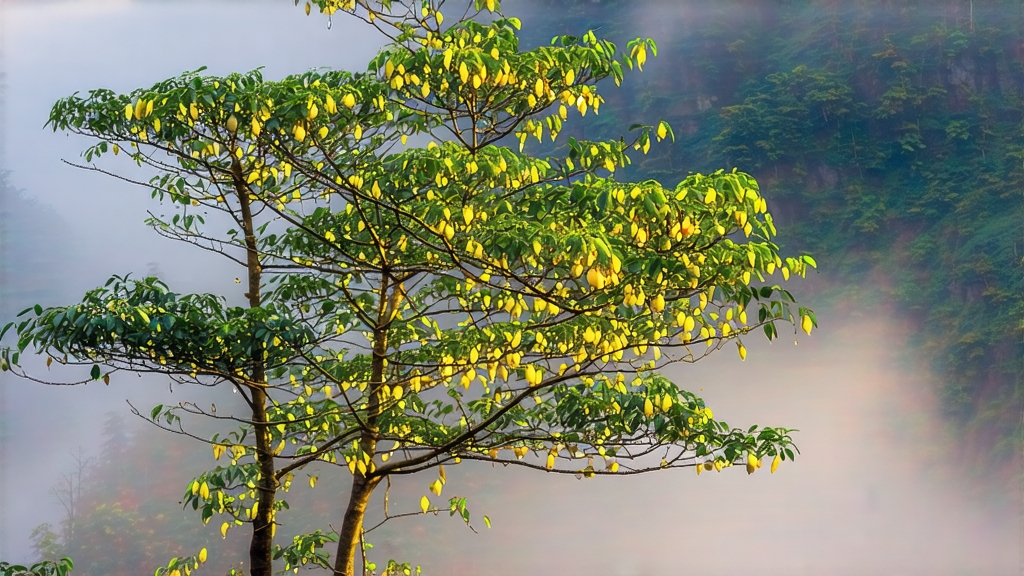
Tucked away in the cloud-veiled peaks of Ya’an, Sichuan, Mengding Huangya has been whispering its golden secret for twelve centuries. Foreign tea lovers often greet yellow tea with a puzzled smile—somewhere between green and pu-erh, yet neither—but one sip of this “Imperial Yellow Bud” erases all confusion. What follows is a complete portrait of the rarest child of the Yellow Tea family, a leaf once reserved for Tang-dynasty emperors and now quietly waiting on the upper shelves of specialty tea shops from Chengdu to Copenhagen.
-
A leaf born in paradise
Mengding Mountain rises 1 456 m above the fertile Sichuan basin where the Min River and the Qingyi River embrace. The latitude (30° N) sits on the same belt that gifts us Darjeeling and matcha, yet the micro-climate is unique: year-round fog reduces direct sunlight to 30 % of normal, forcing the tea bush to synthesize more theanine and fewer bitter catechins. Monastic records from the Tang era already speak of “yellow sprouts offered to the Son of Heaven,” and by the Song dynasty local magistrates had codified the picking ritual: only the single unopened bud, or at most bud-and-first-leaf, harvested between Qingming and Grain Rain when morning mist still lingers. In 1959 the Chinese Ministry of Commerce officially listed Mengding Huangya as one of the “Ten Famous Teas,” cementing its status alongside Longjing and Bi Luo Chun, although export volumes have always remained minuscule—less than 15 t per year—making each gram a time capsule of Chinese court life. -
From green to gold: the sealed yellowing miracle
Unlike green tea whose killing-green step locks in verdant chlorophyll, yellow tea embarks on a second, gentler journey called men huang—“sealed yellowing.” After the buds are pan-fired at 160 °C for four minutes, they are immediately wrapped in thick parchment paper or buried under damp cloth for 4–7 hours. During this micro-fermentation the leaf temperature hovers around 35 °C, high enough to oxidize chlorophyll into pheophytin (the pigment that paints the liquor a luminous apricot) yet low enough to preserve the fresh aroma. Artisans repeat the fire-and-wrap cycle three to five times over 72 hours, monitoring humidity by touch: too dry and the buds remain green; too moist and they collapse into black strips. The result is a leaf that looks sun-kissed rather than sun-burned, with downy tips the color of wheat straw and a fragrance that oscillates between fresh corn and orchid. -
Grades and garden codes
Mengding Huangya is classified into three garden elevations and three picking standards. The highest, Guanyin Cliff (1 350–1 456 m), yields “Golden Tip” harvested exclusively before 10 a.m.; mid-elevation Qingfeng Ridge gives “Silver Bud” (bud plus half-open leaf); while lower terraces produce “Jade Sprout” (bud and one full leaf). Within each tier the leaf is further sorted by length: Grade AAA must be 1.5–2.0 cm, straight like a spear, and contain at least 95 % buds. Such draconian grading means that one kilo of Golden Tip demands 42 000 hand-picked shoots, the daily output of five skilled pluckers. -
Brewing the bud: a west-friendly protocol
Western drinkers often over-steep yellow tea, expecting the muscular punch of Assam. Mengding Huangya prefers delicacy. Use 3 g for a 250 ml glass teapot, water at 80 °C, and an initial infusion of 90 seconds. The buds stand upright like miniature bamboo shoots, then slowly sink, releasing a liquor the color of chardonnay. Second infusion (75 °C, 60 seconds) unveils a creamier body reminiscent of blanched almonds; a third (85 °C, two minutes) adds a faint cocoa note. Because the leaf is so young, you may push four infusions, but stop when the sweetness fades rather than when astringency arrives—yellow tea’s charm is its absence of bite. -
Tasting notes: a sommelier’s grid
Sight: dry leaf—uniform wheat-yellow with ivory tips; wet leaf—translucent jade green at the base, proving the kill-green was